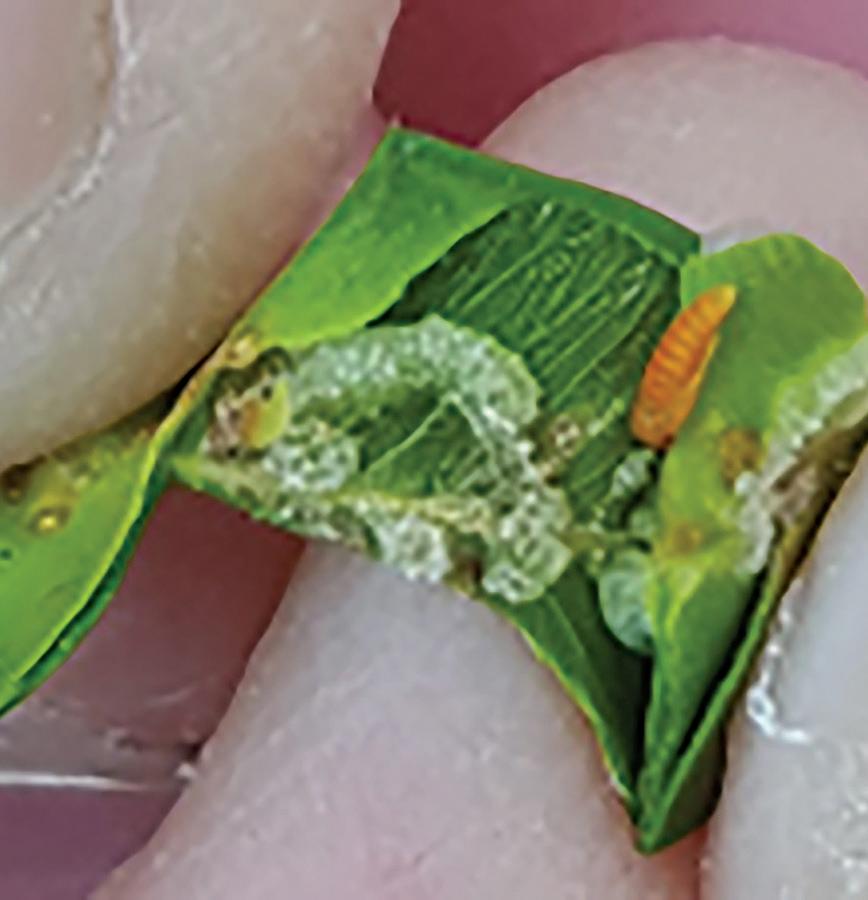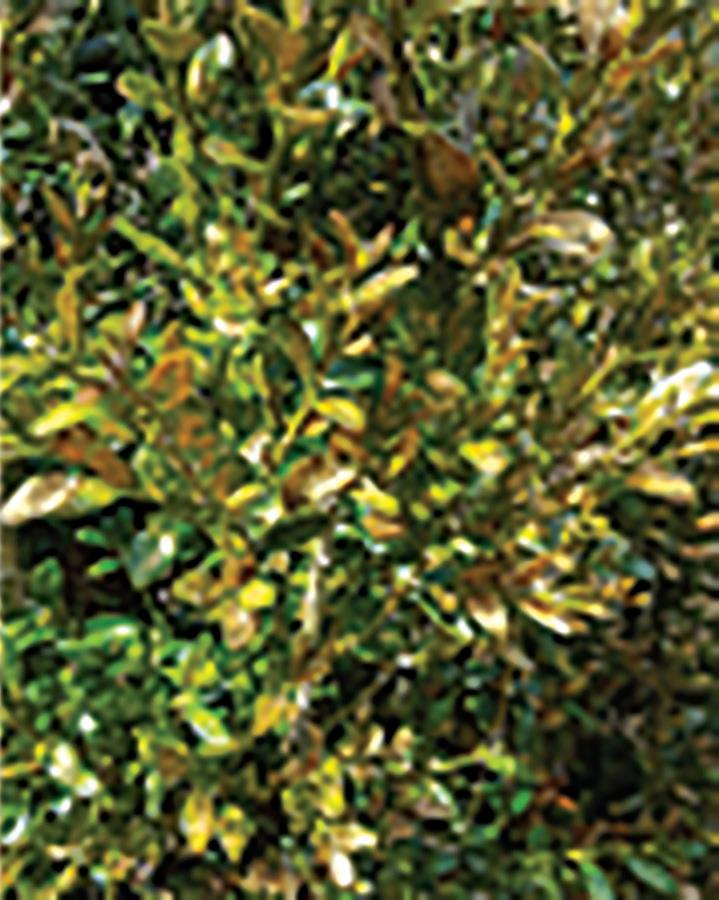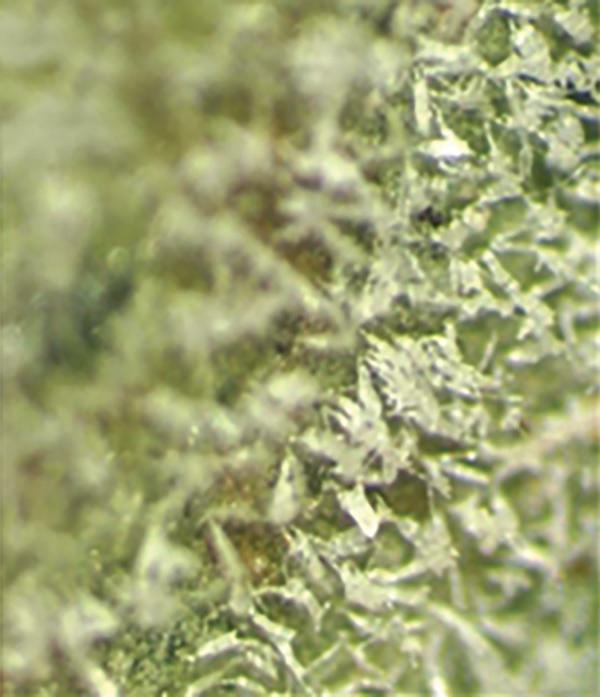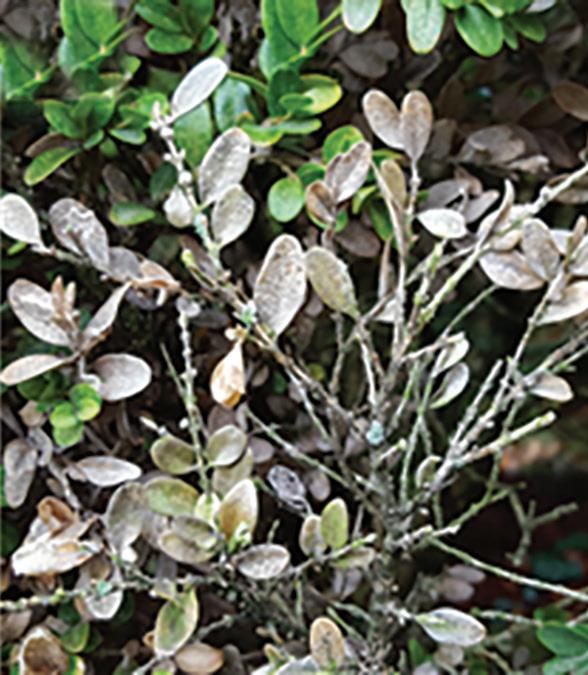
7 minute read
Feature
Boxwood Blight
An Emerging Disease that Keeps Landscapers and Gardeners Awake at Night
Advertisement
By Chuan Hong, Ph.D., Virginia Tech
Boxwood has been the choice evergreen ornamental shrub in landscape designs for homes, public gardens, parks, golf courses, and other green spaces; they accentuate garden entryways, give structure to garden designs, edge garden beds, divide courtyards, designate parking areas, fill window boxes, and create labyrinths. This preference is attributed to several features of boxwood plants: low maintenance, deer resistance, and high tolerance to heavy pruning, and to lesser extent, to drought and cold conditions.
This iconic landscape plant, however, is now endangered due to an emerging disease – boxwood blight caused by a fungal pathogen (Calonectria pseudonaviculata). This disease wiped out the English boxwood gardens at the Woodrow Wilson Presidential Library in 2016, invaded and disfigured historic boxwood plantings at the Tudor Place (October 2018), Longwood Gardens (August 2020), and Colonial Williamsburg (July 2021). It also decimated many private boxwood gardens like this one that had been the family treasure for generations. There have been several lawsuits filed by highly valuable estate owners against landscaping companies, complaining on introducing the blight pathogen to their properties.
To protect customers and landscaping companies themselves from getting into such legal battles, the first and foremost important step is to learn what a blighted boxwood plant and planting looks like, so proper actions may be taken to mitigate the damages to both customers and landscapers, as well as other property owners in the same neighborhood and area.
Boxwood blight infection may start in the garden and landscape where newly introduced host plants including boxwood, pachysandra and sweet box are placed, or may be at first randomly scattered depending upon the means by which the blight pathogen is introduced to a property then spread locally. If the pathogen is introduced by purchasing and bringing in infected plant materials, then spread by contaminated domestic (e.g., dogs, cats) and wild animals (deer), initial infection and blight symptoms usually start low in the canopy, or at the heights at which contaminated animals most likely come in contact with boxwood plants. If the pathogen is spread by contaminated insects and birds, initial infection and blight symptoms may appear wherever the insects and birds land. If the pathogen originates from a nearby property in the neighborhood, it could be introduced by sharing contaminated garden tools, and/or by contaminated runoff water, shoes and other personal belongings. These additional means of pathogen spread often result in new infection and symptoms in lower portion of the canopy.
Boxwood blight has three diagnostic symptoms: 1) leaf spots and blight, 2) black streaks on young stems and branches, and 3) rapid defoliation.
Leaf symptoms begin as small, light to dark black specks that enlarge into discrete spots or diffuse blotches. The spot centers often become tan with an outer ring of black, necrotic tissue. Alternatively, entire leaves may turn completely gray or black without any discrete spot if the pathogen loads are high, plus an extended period of warm and wet conditions. This often results in leaves falling off plants within a week. Leaf symptoms develop more rapidly on English boxwood and other highly susceptible cultivars than those less susceptible ones such as NewGen Boxwood®, Little Missy. Likewise, symptoms develop more quickly on younger than old leaves (Fig. 1).

FIGURE 1
Black streaks on stems and branches are indicative of an advanced stage of disease development and/or favorable environmental conditions. As shown in Fig. 2, multiple black streaks may develop on individual stems and branches, and this is especially apparent on younger stems. Black streaks may have light tan center, and their length and width may vary greatly, depending upon the age of stems and branches, length of disease development time, and conduciveness of the environmental conditions.

FIGURE 2
Similar stem lesions may be caused by two other fungal pathogens — Colletotrichum theobromicola, the causal agent of boxwood dieback/anthracnose, and Pseudonectria spp., the causal agent of Volutella blight. The anthracnose pathogen has been seen in Virginia but it is very limited in distribution in the commonwealth and nationally. Comparatively, the Volutella blight pathogen is ubiquitous but opportunistic, only attacking stressed or weakened boxwood plants.

FIGURE 3a

FIGURE 3b
Rapid defoliation (Fig 4) is typical of boxwood blight on severely affected boxwood plants. This symptom separates boxwood blight from Volutella blight and other diseases as well as winter damages. The only other agent known to be capable of causing extensive defoliation is boxwood leafminer (Monarthropalpus flavus). Leafminer feeding on boxwood leaves causes spotting on their upper surface and blisters on the underside. Slicing into these blisters will reveal adults about to emerge (Fig. 3a). Also accompanying leafminer infestation is extensive leaf browning (Fig. 3b). Boxwood blight does not have any of these symptoms thus can be readily distinguished from leafminer infestation.

FIGURE 4
Under humid conditions the boxwood blight pathogen also produces distinct disease signs on affected stems/branches (Fig. 5A) and leaves (Fig. 5B). These include white pathogen masses — conidiophores bearing long, narrow, hyaline asexual spores (Fig. 5B). These pathogen masses are visible with the naked eye or hand lens, and they appear almost crystalline under a dissecting microscope (Fig. 5B). Under the same conditions, the Volutella blight pathogen also develops spore masses that are at first white then gradually turn to salmon color (Fig. 5C). Additionally, the Macrophoma leaf spot pathogen produces black dot-like fruiting bodies on leaf surface (Fig. 5D). Thus, boxwood blight can be easily distinguished from Volutella blight and Macrophoma leaf spot. Like the Volutella blight pathogen, the Macrophoma leaf spot pathogen is an opportunistic, weak pathogen.

FIGURE 5a

FIGURE 5b

FIGURE 5c

FIGURE 5d
The boxwood blight pathogen spores are sticky, easily attaching to pruners, shoes, other garden tools and personal belongings, and spreading from isolated infections to the entire property and from one property to all other properties wherever contaminated tools are used. Thus, it is highly advisable to walk through the entire boxwood planting on a property and scout for the boxwood blight disease symptoms and sign upon arrival at a job site, and start pruning only if there is no disease symptoms and signs of boxwood blight. Should boxwood blight be suspected, communicate your observations with the customer the importance to take and double bag an affected branch sample then route through your local office of Virginia Cooperative Extension to have it checked by Virginia Tech’s Plant Disease Clinic in Blacksburg or my lab at Hampton Road Agricultural Research and Extension Center in Virginia Beach. Taking this step before starting to work with any boxwood is crucial to preventing pathogen spread and protecting the rest of boxwood plantings on the same property and those in the neighborhood should boxwood blight is confirmed at Virginia Tech.
For more images about the blight disease symptoms and signs on boxwood, pachysandra and sweet box, and general guidelines on how landscapers may help to prevent accidental introduction and spread of the boxwood blight pathogen, please visit the website of Boxwood Blight Insight Group, an international boxwood blight research and education consortium. These topics will be discussed in detail in the coming issues of Virginia Turfgrass.








